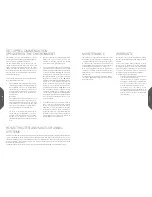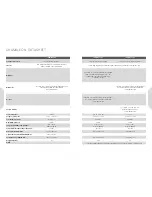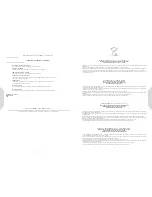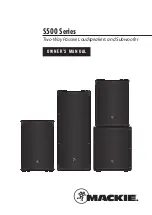
INFORMAZIONI DI SICUREZZA
Regolare le punte/i piedini di appoggio, se presenti, al fine di ottenere la migliore condizione di stabilità. Evitare di appoggiare al
diffusore acustico oggetti estranei che possano comprometterne l’integrità e/o la stabilità.
Nel caso di collocazione del diffusore acustico (se del tipo shelf book) su superfici di appoggio diverse dai supporti previsti (es.
ripiani di librerie a giorno, mensole, mobili TV, ecc.) verificare in via preliminare che la portata relativa sia sufficiente a sostenere il
peso del o dei diffusori acustici. Verificare inoltre che sussista un attrito sufficiente ad evitare spostamenti del diffusore acustico
con le vibrazioni da esso prodotte in condizioni operative; all’occorrenza impiegare dei gommini autoadesivi che potranno essere
reperiti in qualsiasi negozio di ferramenta.
Evitare di appoggiare sul diffusore acustico oggetti contenenti liquidi o sostanze infiammabili o liquefabili.
Attenersi allo schema di collegamento indicato nel manuale di istruzione. Il collegamento in parallelo di due o più diffusori acustici
può danneggiare il Vostro amplificatore. In caso di dubbio rivolgersi al vostro rivenditore di fiducia.
Nel corso del funzionamento dell’impianto audio evitare un ascolto ad alto volume ed in prossimità degli altoparlanti. Ciò può
provocare danni anche permanenti all’apparato uditivo. Mantenete i bambini ad una distanza di sicurezza dal diffusore acustico
di almeno 50 cm.
Gli altoparlanti producono attorno ad essi un campo elettromagnetico innocuo per l’essere umano e per gli animali ma che
può disturbare il funzionamento di apparecchiature elettroniche come monitor e televisori con schermo a tubo catodico
qualora queste vengano collocate nelle immediate vicinanze del diffusore acustico. Nel caso in cui ciò si verifichi, allontanare
semplicemente e lentamente i due apparati uno dall’altro. Per motivi di cautela si sconsiglia di appoggiare sul diffusore acustico
carte di credito o simili a lettura magnetica.
La tecnologia di funzionamento degli altoparlanti verte su principi dell’elettromagnetismo e pertanto l’utilizzatore dovrà evitare di
utilizzare apparati che generino forti campi elettromagnetici, i quali potrebbero disturbare il funzionamento del diffusore acustico.
Evitare di appoggiare su di esso apparati di ricetrasmissione come telefoni cellulari, cordless, sistemi intercom, ecc.
Non collegare direttamente ad un impianto per diffusione sonora a tensione costante (100V, 70.7V o simili). Ciò può determinare
il sovraccarico dell’impianto stesso con possibile danneggiamento del diffusore acustico e/o della centralina di amplificazione.
Mantenere a distanza cavi di collegamento ampli-diffusore acustico e cavi di alimentazione di rete. Questi ultimi convogliano una
tensione alternata alla frequenza di 50Hz (60Hz in Giappone e negli Stati Uniti) ed intensità che può essere elevata e come tali
producono attorno ad essi un campo elettromagnetico di frequenze audio. In caso di accoppiamento tra cavi di segnale e cavi di
alimentazione, la conseguenza sarà la comparsa di un fastidioso ronzio. Nel caso in cui ciò si verifichi provvedere ad allontanare
tra di loro cavi di segnale e cavi di alimentazione.
Prestare grande attenzione al montaggio/smontaggio del pettine tendifilo, se presente. Assicurarsi che i perni della staffa inferiore
siano ben inseriti nelle rispettive sedi prima di tendere i fili per fissare la staffa superiore.
I morsetti serrafilo sono provvisti di innesto per connettore a banana (banana plug) ostruito da tappo rimovibile al fine di evitare
accidentali collegamenti a prese di rete elettrica non protette. Rimuovere i tappi in plastica rossa e nera unicamente nel caso si
intenda avvalersi di detto tipo di terminazione e cautelarsi che l’altro capo del cavo venga collegato ai morsetti di uscita di potenza
dell’amplificatore.
SAFETY INFORMATION
Install the speakers in order to achieve the best possible stability. If it’s the case, adjust points/feet supports. Avoid placing heavy
objects on the speaker as they can compromise its stability.
In case the speaker is placed on a surface other than the suggested stands (ex. shelves, bookcases, TV supports, etc.) or directly
the floor, firstly check that it can support the weight of the speaker(s). Also check that there is enough friction between the speaker
and the surface in order to avoid any movement caused through vibrations whilst in use. Where needed rubber adhesive feet can
be purchased from all good hardware stores.
Do not put any objects containing water or other liquid/liquefiable substance on the speaker system.
Follow the connection diagram suggested in the instructions manual. Remember that the parallel connection of two or more
speakers can damage your amplifier. If in doubt, contact your dealer.
Whilst the audio system is operative at high volumes avoid staying in close proximity to the speaker system. This can cause
permanent damage to your hearing! Children should maintain a safe distance from the speaker system of at least 50 cm.
The speakers produce an electromagnetic field which is harmless to humans and pets, but they can cause disturbances in
the correct functioning of electronic equipment such as monitors or cathode tube TVs when placed in close proximity. If this
occurs, simply and slowly distance one from the other. As a further precaution, it is not advisable to place credit cards or similar
magnetically read objects on top of the speaker system.
The technology behind the functioning of the speakers is based on the principles of electromagnetism, and thus the user should
avoid operating equipment that generates strong electromagnetic fields as these could affect the correct functioning of the
speaker. Avoid placing transmitting devices such as mobile phones, cordless phones, intercom systems etc. on top of the speaker
systems.
Do not directly connect to a constant voltage (100V, 70.7V or similar) sound distribution system. This could have as a consequence
a serious system’s overload with probable damages to the loudspeaker system and/or the amplifier unit.
Keep amplifier-speaker connection and power (mains) cables separate. Mains cables carry an alternating voltage at a frequency
of 50Hz (60Hz in Japan and the USA) and an intensity that can be high, and thus produce an electromagnetic field even at audio
frequency around them. In the case of coupling of these two types of cables an annoying hum noise will be perceived through
the speakers. If this should occur, do provide an adequate distance between the cables.
Be very careful during the assembly and disassembly of the rubber string grille, if present. Check that the first metal string holder
is properly inserted before tightening the strings to secure the second one.
The speaker cable terminals accept banana plugs. Remove the red and black plastic caps only if you intend to implement this
type of connection and ensure that the other end of the cable is connected to the power output terminals of your amplifier. This
protection is aimed at avoiding accidental connection to unprotected electrical outlets.
Summary of Contents for CHAMELEON SERIES
Page 1: ......
Page 12: ...SUPPORT DRAWINGS 1 ...
Page 13: ...SUPPORT DRAWINGS 2 3 ...
Page 14: ...SUPPORT DRAWINGS 4 5 ...
Page 15: ...SUPPORT DRAWINGS 6 7 8 9 10 11 ...
Page 16: ...SUPPORT DRAWINGS 12 13 ...
Page 21: ......







































